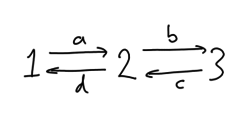Difference between revisions of "M(4,2,2)"
(Rearranged labelling for simples) |
m |
||
| (7 intermediate revisions by the same user not shown) | |||
| Line 8: | Line 8: | ||
|l(B) = 3 | |l(B) = 3 | ||
|k-morita-frob = 1 | |k-morita-frob = 1 | ||
| − | |Pic-k= <math>k^* \wr C_2</math> | + | |Pic-k= <math>k^* \wr C_2</math><ref>This is an elementary calculation</ref> |
|cartan = <math>\left( \begin{array}{ccc} | |cartan = <math>\left( \begin{array}{ccc} | ||
2 & 2 & 1 \\ | 2 & 2 & 1 \\ | ||
| Line 25: | Line 25: | ||
\end{array}\right)</math> | \end{array}\right)</math> | ||
|O-morita-frob = 1 | |O-morita-frob = 1 | ||
| − | |Pic-O = <math>\mathcal{T}(B)=C_2</math> | + | |Pic-O = <math>\mathcal{T}(B)=C_2</math><ref>Every Morita equivalence is a source algebra equivalence by [[References#C|[CEKL13]]], so <math>{\rm Pic}(B)=\mathcal{T}(B)</math></ref> |
| + | |PIgroup = <math>S_4 \times C_2</math><ref>This follows from the result for [[M(4,2,3)]] since blocks in these classes are derived equivalent and so perfectly isometric</ref> | ||
|source? = Yes | |source? = Yes | ||
|sourcereps = <math>B_0(\mathcal{O}A_5)</math> | |sourcereps = <math>B_0(\mathcal{O}A_5)</math> | ||
| Line 31: | Line 32: | ||
|k-derived = [[M(4,2,3)]] | |k-derived = [[M(4,2,3)]] | ||
|O-derived-known? = Yes | |O-derived-known? = Yes | ||
| + | |coveringblocks = M(4,2,2) (complete) | ||
| + | |coveredblocks = M(4,2,2) (complete) | ||
| + | |pcoveringblocks = [[M(8,3,2)]], [[M(8,5,2)]] (complete)<ref>A covering block cannot have defect group <math>C_4 \times C_2</math>.</ref> | ||
}} | }} | ||
| Line 42: | Line 46: | ||
== Other notatable representatives == | == Other notatable representatives == | ||
| − | |||
| − | |||
| − | |||
| − | |||
| − | |||
| − | |||
== Projective indecomposable modules == | == Projective indecomposable modules == | ||
| Line 64: | Line 62: | ||
\begin{array}{ccc} | \begin{array}{ccc} | ||
& S_2 & \\ | & S_2 & \\ | ||
| − | S_1 & & S_3 \\ | + | \begin{array}{c} S_1 \\ S_2 \\ S_3 \\ \end{array} & \oplus & \begin{array}{c} S_3 \\ S_2 \\ S_1 \\ \end{array} \\ |
| − | |||
| − | |||
& S_2 & \\ | & S_2 & \\ | ||
\end{array}, | \end{array}, | ||
| Line 85: | Line 81: | ||
[[C2xC2|Back to <math>C_2 \times C_2</math>]] | [[C2xC2|Back to <math>C_2 \times C_2</math>]] | ||
| + | |||
| + | == Notes == | ||
| + | |||
| + | <references /> | ||
[[Category: Morita equivalence classes|4,2,2]] | [[Category: Morita equivalence classes|4,2,2]] | ||
[[Category: Blocks with defect group C2xC2]] | [[Category: Blocks with defect group C2xC2]] | ||
[[Category: Tame blocks|4,2,2]] | [[Category: Tame blocks|4,2,2]] | ||
Latest revision as of 14:47, 4 January 2019
| Representative: | [math]B_0(kA_5)[/math] |
|---|---|
| Defect groups: | [math]C_2 \times C_2[/math] |
| Inertial quotients: | [math]C_3[/math] |
| [math]k(B)=[/math] | 4 |
| [math]l(B)=[/math] | 3 |
| [math]{\rm mf}_k(B)=[/math] | 1 |
| [math]{\rm Pic}_k(B)=[/math] | [math]k^* \wr C_2[/math][1] |
| Cartan matrix: | [math]\left( \begin{array}{ccc} 2 & 2 & 1 \\ 2 & 4 & 2 \\ 1 & 2 & 2 \\ \end{array} \right)[/math] |
| Defect group Morita invariant? | Yes |
| Inertial quotient Morita invariant? | Yes |
| [math]\mathcal{O}[/math]-Morita classes known? | Yes |
| [math]\mathcal{O}[/math]-Morita classes: | [math]B_0(\mathcal{O}A_5)[/math] |
| Decomposition matrices: | [math]\left( \begin{array}{ccc} 0 & 1 & 0 \\ 1 & 1 & 0 \\ 0 & 1 & 1 \\ 1 & 1 & 1 \\ \end{array}\right)[/math] |
| [math]{\rm mf}_\mathcal{O}(B)=[/math] | 1 |
| [math]{\rm Pic}_{\mathcal{O}}(B)=[/math] | [math]\mathcal{T}(B)=C_2[/math][2] |
| [math]PI(B)=[/math] | [math]S_4 \times C_2[/math][3] |
| Source algebras known? | Yes |
| Source algebra reps: | [math]B_0(\mathcal{O}A_5)[/math] |
| [math]k[/math]-derived equiv. classes known? | Yes |
| [math]k[/math]-derived equivalent to: | M(4,2,3) |
| [math]\mathcal{O}[/math]-derived equiv. classes known? | Yes |
| [math]p'[/math]-index covering blocks: | M(4,2,2) (complete) |
| [math]p'[/math]-index covered blocks: | M(4,2,2) (complete) |
| Index [math]p[/math] covering blocks: | M(8,3,2), M(8,5,2) (complete)[4] |
Contents
Basic algebra
Quiver: a:<1,2>, b:<2,3>, c:<3,2>, d:<2,1>
Relations w.r.t. [math]k[/math]: ad=cb=bcda+dabc=0
Other notatable representatives
Projective indecomposable modules
Labelling the simple [math]B[/math]-modules by [math]S_1, S_2, S_3[/math], the projective indecomposable modules have Loewy structure as follows:
[math]\begin{array}{ccc} \begin{array}{c} S_1 \\ S_2 \\ S_3 \\ S_2 \\ S_1 \\ \end{array}, & \begin{array}{ccc} & S_2 & \\ \begin{array}{c} S_1 \\ S_2 \\ S_3 \\ \end{array} & \oplus & \begin{array}{c} S_3 \\ S_2 \\ S_1 \\ \end{array} \\ & S_2 & \\ \end{array}, & \begin{array}{c} S_3 \\ S_2 \\ S_1 \\ S_2 \\ S_3 \\ \end{array} \end{array} [/math]
Irreducible characters
All irreducible characters have height zero.
Back to [math]C_2 \times C_2[/math]
Notes
- ↑ This is an elementary calculation
- ↑ Every Morita equivalence is a source algebra equivalence by [CEKL13], so [math]{\rm Pic}(B)=\mathcal{T}(B)[/math]
- ↑ This follows from the result for M(4,2,3) since blocks in these classes are derived equivalent and so perfectly isometric
- ↑ A covering block cannot have defect group [math]C_4 \times C_2[/math].
